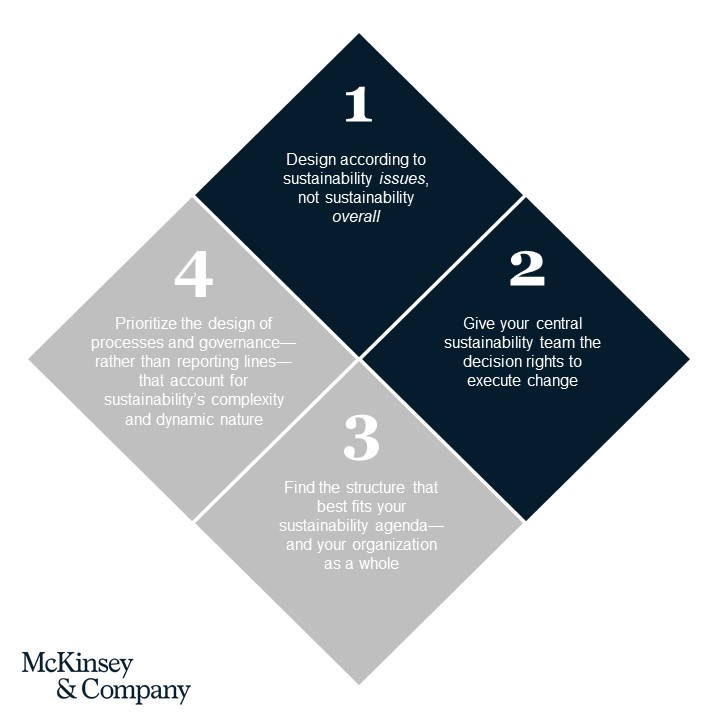Companies are increasingly recognizing sustainability as a strategic priority. With stakeholders at every level demanding that organizations take a real stand, companies that merely pay lip service cannot compete. Sustainability today must become more than a public relations, investor relations, or corporate social responsibility endeavor. The modern sustainability organization must be set up to reshape a company’s fundamental approach to business, set specific goals, and accomplish real results. However, historically, few companies have organizational structures designed to treat sustainability as a material business issue, and it’s time to evolve.
There are four principles to creating sustainability teams that can hold the enterprise accountable, meet stakeholders’ increasing expectations, manage risks, and capture business opportunities. Let’s examine the first two.

Design according to specific sustainability issues, not sustainability overall
Sustainability is often used as a catchall term covering many topics. Our work shows that companies address sustainability more effectively when they prioritize specific issues—such as carbon emissions or waste management—and design their sustainability efforts accordingly. This enables better decisions on resourcing and organizing. A materiality assessment is a common approach to identify priorities, whether based on potential business impact or the company’s unique position to make a difference.
When it comes to supporting sustainability work on specific issues, modular organization design—rather than one holistic, central sustainability team—often works best. A modular design typically has several centers of excellence around different sustainability issues or opportunities, with significant resources embedded into business operations but networked back to the center and to other businesses working on similar issues. This gives companies the nimbleness to address emerging needs in an agile way. When establishing a dedicated center of excellence for an issue, the organization may opt to position that team primarily at the center or mostly embedded in a business unit with relevant expertise or primary responsibility.
One company identified carbon management as a priority sustainability issue, and it built a dedicated, lean team to coordinate all carbon-emissions efforts and reporting and distribute initiatives among different parts of the company. For example, the R&D department focused on low-carbon innovations, manufacturing sites launched decarbonization initiatives aligned with site-level turnaround schedules, and the procurement team decarbonized the supply chain.
Give your central sustainability team the decision rights to execute change
It’s important for companies to have a central team that shapes the overall sustainability strategy, sets and adjusts goals, guides resource allocation, and coordinates the modular teams’ work on a given issue. To be effective, that central team must be empowered to make decisions, execute change, and engage leadership—particularly on cross-functional sustainability issues. They need the authority to hold individual sites or business units accountable for devising specific initiatives and timelines for pursuing centrally set targets. The team can track their progress, while maintaining an enterprise-wide view of the company’s performance.
While the central sustainability team needs decision-making authority, they need not be the default on everything. Decisions that involve single functions can be assigned to leaders or teams more closely associated with those units. This reserves the central team’s time for cross-functional decisions and those that are highly material to the full company.
The central group should have the ability to engage the board and executive management team as the ultimate arbiters on strategic direction. The team may also enlist the company’s leaders to define a corporate-level sustainability agenda. When the team has a clear mandate from the business, it can better cascade through the organization, ensuring engagement in and commitment to common sustainability goals.
***
As sustainability becomes a more integral part of corporate strategy, a well-designed team—one dedicated to specific sustainability issues and authorized to make decisions—can help capture value and manage risks in a systematic and even transformational way. In our next post, we discuss the second two principles for organizing effective sustainability teams.


